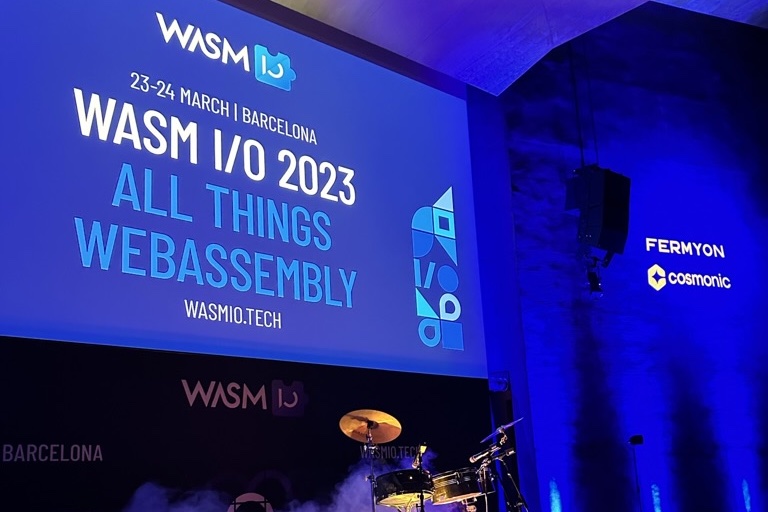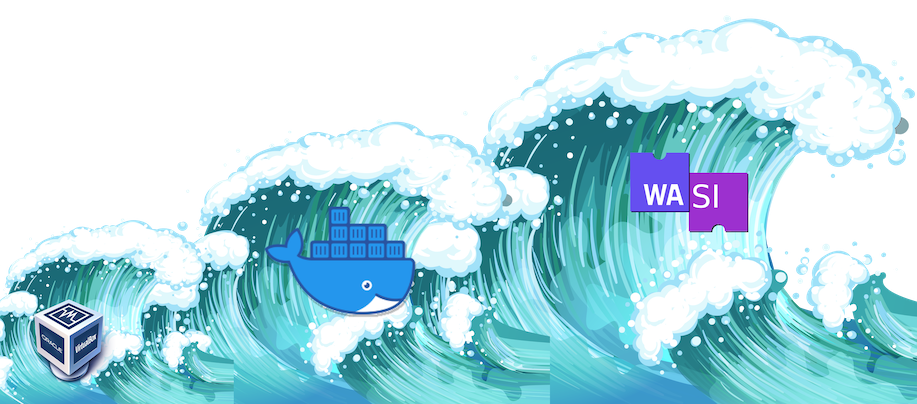

Surfing the Third Wave: 5 things I learned about WebAssembly in Barcelona
October 10, 2023
In March I attended the debut of the Wasm IO conference, arranged in Barcelona, courtesy of a generous course and conference budget from my employer, JProfessionals. This lets me explore technologies that catch my interest and might be relevant for our customers.

The conference brought together leading experts from around the world to discuss the latest advancements and innovations in Wasm. In this blog post I will share with you 5 things I learned in Barcelona and attempt to describe the exciting future heralded as the third wave of cloud computing.
First of all, what is Wasm? 🤔

WebAssembly, often abbreviated as Wasm, is a low-level binary format designed to run alongside JavaScript in web browsers. You can write code in a language you already know, including C, C++, Go, and Rust, and compile it to Wasm. Figma, the company Adobe is aiming to aquire for 20$ billion dollars (🤯), has been using Wasm to bring their design tool written in C++ to run in the browser since 2017.
The Mozilla Foundation initially designed and developed Wasm to complement JavaScript in the browser, but its "run everywhere, fast, secure, and efficient" philosophy translated well to server-side applications as well, through a Wasm runtime like Wasmtime. Shopify and Fastly already uses Wasmtime for hosting their Edge functions. Thanks to the efforts of Wasmtime and other runtimes like it we're now able to run Wasm outside the browser, but how do we make a technology designed to run sandboxed in a browser perform operations we expect of a server? That's where WASI comes in.
1. WASI is a pretty cool project 😎
WebAssembly System Interface, or WASI, is an API designed to allow WebAssembly applications access to system features like file and filesystem access. With WASI, developers can bring Wasm out of the browser and into server applications. WASI aims to promote code re-usability, cross-platform applications, and containerization.

When WASI was announced back in March 2019, Solomon Hykes, the creator of Docker, tweeted this:
"If Wasm+WASI existed in 2008, we wouldn't have needed to create Docker. That's how important it is. Webassembly on the server is the future of computing. A standardized system interface was the missing link. Let's hope WASI is up to the task!" - Solomon Hykes
This quote foreshadowed a potential new wave of cloud computing.
Talks about WASI:
- The World of WASI: Technical introduction to the past, present and future of WASI
- wasi-cloud: The Future of Cloud Computing With WebAssembly: Introducing a collection of WASI proposals that provide secure and standarised interfaces for running Wasm on the cloud
2. We're entering the third wave of cloud computing 🏄

The first wave of cloud computing saw the rise of virtual machines running on managed infrastructure. The following second wave is attributed to the rise of containerization and orchestration through tools like Docker and Kubernetes.
We've come a long way since the days of self-managed on-premise data centers, but rather than having companies hire their own infrastructure engineers to manage proprietary servers, they now hire DevOps engineers to build and develop proprietary developer platforms. Serverless computing offers a solution to this, enabling developers to simply write the code and run it without having to manage entire platforms.
While serverless and its subset functions-as-a-service (FaaS) have been around for a while, they still rely on the advancements of the previous two waves. This is where everyone who attended Wasm IO sees the potential for WebAssembly to address the limitations of current platforms and usher in the third wave of cloud computing.
Imagine a world where you write chunks of a given service/application in different programming languages, choosing the best suited language for each task, which is then compiled into a single target that can run anywhere a Wasm runtime can run?
3. We might see the return of "Write once, run everywhere" 🤔
Tyler McMullen, CTO of Fastly, shared his insights on Wasm and its potential to revolutionize the way software developers develop by enabling us to "actually write once, run everywhere".
During his talk, McMullen used Fastly's journey to illustrate how we have reached a point where we can "write once, run everywhere". By this he means "Write once, run everywhere safely", implying that the programs we create should be able to operate safely on any device on any architecture, on everything from browsers to servers, ARM to intel and embedded devices.
This allows developers to write code in one programming language, and run in any other language, as long as both languages support Wasm as a compilation target. Imagine creating a library in any supported language adding it as a dependency in all your code bases without needing to refactor.
But wait, were we not promised the same thing with Java Applets? It promised a similar "write once, run everywhere" approach. What went wrong with Java? According to McMullen, Java lacked a fundamental sandboxing and security model from the beginning, which led to constant vulnerabilities across the numerous devices it aimed to target. While it was theoretically possible to run Java programs on any device, the question remains - should you?
Turns out, Wasm can also used in Java, opening up new possibilities for this language as well. 🤓
You can watch Tyler's talk here
4. You will be able to tap into Wasm in Java and Kotlin applications
If you're a Java or Kotlin developer and curious about how to use WebAssembly in your applications, there were two talks that presented projects that can prove helpful in the future.
One project, called Extism, aims to let you develop Wasm plugins in various languages that can be utilised in your Java programs. As previously mentioned, one of the most exciting aspects of Wasm is the ability to write code in one language and run it in others. Extism aims to make progress towards that goal. You can learn more about it here.
Another talk, led by Zalim Bashorov, a JetBrains employee leading the integration of Wasm into the Kotlin ecosystem, and Sébastien Deleuze, a core committer of the Spring Framework, introduced the KoWasm project. Initially, Wasm in Kotlin has been used to target web browsers, but this project seeks to leverage WASI to facilitate server-side and full stack development. The main concept is to have all the code, both server-side and browser-based, compiled to Wasm and run on Wasm runtimes universally.
The talks:
That all sounds great, but how would you go about trying all this out?
5. Spin by Fermyon is ready for production
One of the main sponsors of the conference, Fermyon, kicked off the conference with announcing that their developer tool, Spin, hit 1.0 and is production ready. Fermyon is one of the companies surfing ahead of the curve and attempting to make the third wave a success.
Fermyon describes spin on their website as such;
Spin is the developer tool for building WebAssembly microservices and web applications.
What they promise is that you can bring your own supported WASI-compatible language, write your application and deploy on a Fermyon instance. You can either use their own proprietary SaaS, Fermyon Cloud, or you can install Fermyon on other platforms, like AWS, Azure or GCP.
Thorsten Hans, a Cloud-native consultant from Germany, held a great talk about getting started with Spin with: Spin it! Jumpstart your Wasm journey with Fermyon Spin
To read more about Spin
What now?
I wouldn't say it's time to tear down all developer platforms relying on Docker and Kubernetes, but after this conference I'm pretty convinced WebAssembly will play a big role in the future of our Cloud. Writing Wasm by itself seems like a chore, but I have some great resources that can help you getting started, relying on perhaps more familiar languages.
- Wasm by example: A great hands-on introduction using code snippets from languages like Rust and AssemblyScript. If you're mainly a TypeScript developer like myself, the examples in AssemblyScript will be familiar.
- Fermyon Workshop: I attended a workshop hosted by Fermyon, where they tasked us with picking a supported language and build a simple magic 8 ball application and deploy it, all with Spin. I chose Rust, and spent most of the time fighting with ownership, and in hindsight should have chosen TypeScript. You can follow the exercices from the link, and it should give you a some pointers on what you can do with this.
Personally, I'm not entirely convinced that we'll abandon Docker and Kubernetes in favor of Wasm, but we might see a world where they work in tandem, complementing each other. Maybe that is what the third wave of cloud computing will end up being?
Who knows what the fourth wave will bring? 🏄




